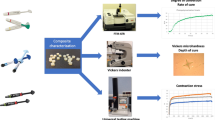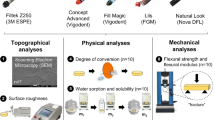Abstract
Objectives
To analyze and compare, in vitro, the microhardness, sorption, solubility, color stability, and cytotoxicity of three types of resin composites: self-adhesive (SARC) (Dyad Flow (DF)/Kerr), bulk-fill (Filtek Bulk Fill Flow (FBF)/3 M ESPE), and conventional (Filtek Z350XT Flow (Z350)/3 M ESPE).
Materials and methods
Thirty cylindrical specimens were prepared using a split metal mold (15 mm × 1 mm), divided into 3 groups (n = 10) according to the material used. Vickers hardness (VH) was calculated from three indentations (300gf/15 s) per specimen. The sorption and solubility were measured according to the ISO 4049:2009 specification after storing in distilled water for 7 days. The color of each resin composite was measured using a portable digital spectrophotometer according to the CIELAB system. After a 7-day immersion in coffee, the color variation (∆E) was calculated. Following the ISO 10993:2012, the cytotoxicity in Vero cells was evaluated through the MTT assay. The results were analyzed using the Kruskal–Wallis test to compare the studied groups. The Wilcoxon test was used to compare the assessments in each studied group. For cytotoxicity analysis, the data were compared by the ANOVA test (α = 0.05).
Results
DF showed the lowest VH (28.67), highest sorption (0.543 µg/mm3) and solubility (1.700 µg/mm3), and higher ∆E after 7 days of coffee immersion (p = 0.008). The resin composites studied were considered non-cytotoxic.
Conclusions
The SARC presented inferior mechanical and physical–chemical properties than bulk-fill and conventional resin composites, with comparable cytotoxicity against Vero cells.
Clinical relevance
The simplification of the clinical protocol of SARC can minimize the number of possible failures during the restorative technique. However, considering their inferior physical and mechanical properties, their coverage with materials of higher mechanical properties and physical–chemical stability should be considered.

Similar content being viewed by others
References
Oliveira NG, Lima ASLC, Silveira MT, Araújo PRS, Monteiro GQM, Carvalho MV (2019) Evaluation of postoperative sensitivity in restorations with self-adhesive resin: a randomized split-mouth design-controlled study. Clin Oral Investig 24:1829–1835. https://doi.org/10.1007/s00784-019-03046-0
De Brito OFF, De Oliveira ILM, Monteiro GQM (2019) Hydrolytic and biological degradation of bulk-fill and self-adhering resin composites. Oper Dent 44:E223–E233. https://doi.org/10.2341/17-390-L
Boaro LCC, Lopes DP, de Souza ASC, Nakano EL, Perez MDA, Pfeifer CS, Gonçalves F (2019) Clinical performance and chemical-physical properties of bulk fill composites resin - a systematic review and meta- analysis. Dent Mater 35:e249–e264. https://doi.org/10.1016/j.dental.2019.07.007
Szesz A, Parreiras S, Martini E, Reis A, Loguercio A (2017) Effect of flowable composites on the clinical performance of non-carious cervical lesions: a systematic review and meta-analysis. J Dent 65:11–21. https://doi.org/10.1016/j.jdent.2017.07.007
Canali GD, Ignácio SA, Rached RN, Souza EM (2019) One-year clinical evaluation of bulk-fill flowable vs. regular nanofilled composite in non-carious cervical lesions. Clin Oral Investig 23:889–897. https://doi.org/10.1007/s00784-018-2509-8
David C, Cardoso CG, Isolan CP, Piva E, Moraes RR, Cuevas-Suarez CE (2021) Bond strength of self- adhesive flowable composite resins to dental tissues: a systematic review and meta-analysis of in vitro studies. J Prosthet Dent 7: S0022–3913(21)00102–5. https://doi.org/10.1016/j.prosdent.2021.02.020
Durão MA, Andrade AKM, Santos MCMS, Montes MAJR, Monteiro GQM (2021) Clinical performance of bulk-fill resin composite restorations using the United States Public Health Service and Federation Dentaire Internationale Criteria: a 12-month randomized clinical trial. Eur J Dent 15:179–192. https://doi.org/10.1055/s-0040-1718639
Marigo L, Spagnuolo G, Malara F, Martorana GE, Cordaro M, Lupi A, Nocca G (2015) Relation between conversion degree and cytotoxicity of a flowable bulk-fill and three conventional flowable resin-composites. Eur Rev Med Pharmacol Sci 19:4469–4480
Rizzante FAP, Duque JA, Duarte MAH, Mondelli RFL, Mendonça G, Ishikiriama SK (2019) Polymerization shrinkage, microhardness and depth of cure of bulk fill resin composites. Dent Mater J 38:403–410. https://doi.org/10.4012/dmj.2018-063
Maas MS, Alania Y, Natale LC, Rodrigues MC, Watts DC, Braga RR (2017) Trends in restorative composites research: what is in the future? Braz Oral Res 31:e55. https://doi.org/10.1590/1807-3107BOR-2017.vol31.0055
Shafiei F, Saadat M (2016) Micromorphology and bond strength evaluation of adhesive interface of a self-adhering flowable composite resin-dentin: effect of surface treatment. Microsc Res Tech 79:403–407. https://doi.org/10.1002/jemt.22643
Pan Y, Xu X, Sun F, Meng X (2018) Surface morphology and mechanical properties of conventional and self-adhesive resin cements after aqueous aging. J Appl Oral Sci 27:e20170449. https://doi.org/10.1590/1678-7757-2017-0449
Ferracane JL, Stansburry JW, Burke FJT (2011) Self-adhesive resin cements – chemistry, properties and clinical considerations. J Oral Rehabil 38:295–314. https://doi.org/10.1111/j.1365-2842.2010.02148.x
Hanabusa M, Mine A, Kuboki T, Momoi Y, Landuyt KLV, Meerbeek BV, Munck JD (2011) TEM interfacial characterization of an experimental self-adhesive filling material bonded to enamel/dentin. Dent Mater 27:818–824. https://doi.org/10.1016/j.dental.2011.04.007
Chesterman J, Jowett A, Gallacher A, Nixon P (2017) Bulk-fill resin-based composite restorative materials: a review. Br Dent J 222:337–344. https://doi.org/10.1038/sj.bdj.2017.214
Hashemikamangar SS, Meymand MZ, Kharazifard MJ, Valizadeh S (2020) Surface microhardness of a self-adhesive composite in comparison with conventional composite resins. Dent Med Probl 57:247–253. https://doi.org/10.17219/dmp/118123
Espíndola-Castro LF, Durão MA, Pereira TVG, Cordeiro AKB, Monteiro GQM (2020) Evaluation of microhardness, sorption, solubility, and color stability of bulk fill resins: a comparative study. J Clin Exp Dent 12:e1033–e1038. https://doi.org/10.4317/jced.57599
Hashemikamangar SS, Meymand MZ, Kharazifard MJ, Valizadeh S (2020) Surface microhardness of a self-adhesive composite in comparison with conventional composite resins. Dent Med Probl 57:247–253. https://doi.org/10.17219/dmp/118123
International Organization for Standardization. ISO 4049: Dentistry polymer – based filling, restorative and luting materials. Switzerland, 2009. Available at: https://www.iso.org/standard/42898.html. Accessed February 5, 2020
Shiozawa M, Takahashi H, Asakawa Y, Iwasaki N (2015) Color stability of adhesive resin cements after immersion in coffee. Clin Oral Investig 19:309–317. https://doi.org/10.1007/s00784-014-1272-8
Espíndola-Castro LF, Brito OFF, Araújo LGA, Santos ILA, Monteiro GQM (2020) In vitro evaluation of physical and mechanical properties of light-curing resin cement: a comparative study. Eur J Dent 14:152–156. https://doi.org/10.1055/s-0040-1705075
International Organization for Standardization. ISO 10993: Biological evaluation of medical devices - Part 5: Tests for In vitro cytotoxicity. Switzerland, 2009. Available at: https://www.iso.org/standard/42898.html.Accessed February 5, 2020
Liebermann A, Wimmer T, Schmidlin PR, Scherer H, Loffler P, Malgorzata R, Stawarczyk B (2016) Physicomechanical characterization of polyetheretherketone and current esthetic dental CAD/CAM polymers after aging in different storage media. J Prosthet Dent 115:321-328.e2. https://doi.org/10.1016/j.prosdent.2015.09.004
Blackham JT, Vandewalle KS, Lien W (2009) Properties of hybrid resin composite systems containing prepolymerized filler particles. Oper Dent 34:697–702. https://doi.org/10.2341/08-118-L
Arregui M, Giner L, Ferrari M, Mercadé M (2015) Colour stability of self-adhesive flowable composites before and after storage in water. Key Eng Mater 631:143–150. https://doi.org/10.4028/www.scientific.net/KEM.631.143
Alshali RZ, Salim NA, Satterthwaite JD, Silikas N (2015) Long-term sorption and solubility of bulk-fill and conventional resin-composites in water and artificial saliva. J Dent 43:1511–1518. https://doi.org/10.1016/j.jdent.2015.10.001
Heintze SD, Zimmerli B (2011) Relevance of in vitro tests of adhesive and composite dental materials, a review in 3 parts. Part 1: approval requirements and standardized testing of composite materials according to ISO specifications. Schweiz Monatsschr Zahnmed 121:804–816
Gonçalves L, Jaime Filho D, Guimarães JG, Poskus LT, Silva EM (2008) Solubility, salivary sorption and degree of conversion of dimethacrylate based polymeric matrixes. J Biomed Mater Res B Appl Biomater 85:320–325. https://doi.org/10.1002/jbm.b.30949
Sokolowski G, Szczesio A, Bociong K, Kaluzinska K, Lapinska B, Sokolowski J, Domarecka M, Lukomska- Szymanska M (2018) Dental resin cements – the influence of water sorption on contraction stress changes and hydroscopic expansion. Materials (Basel) 11:973. https://doi.org/10.3390/ma11060973
Bagheri R, Mese A, Burrow MF, Tyas MJ (2010) Comparison of the effect of storage media on shear punch strength of resin luting cements. J Dent 38:820–827. https://doi.org/10.1016/j.jdent.2010.06.014
Prado V, Santos K, Fontenele R, Soares J, Vale G (2020) Effect of over the counter mouthwashes with and without alcohol on sorption and solubility of bulk fill resins. J Clin Exp Dent 12:e1150–e1156. https://doi.org/10.4317/jced.57234
Valizadeh S, Asiaie Z, Kiomarsi N, Kharazifard MJ (2020) Color stability of self-adhering composite resins in different solutions. Dent Med Probl 57:31–38. https://doi.org/10.17219/dmp/114099
Guler S, Unal M (2018) The evaluation of color and surface roughness changes in resin based restorative materials with different contents after waiting in various liquids: an SEM and AFM study. Microsc Res Tech 81:1422–1433. https://doi.org/10.1002/jemt.23104
Bagheri R, Burrow MF, Tyas M (2005) Influence of food-simulating solutions and surface finish on susceptibility to staining of aesthetic restorative materials. J Dent 33:389–398. https://doi.org/10.1016/j.jdent.2004.10.018
Salgado VE, Rego GF, Schneider LF, Moraes RR, Cavalcante LM (2018) Does translucency influence cure efficiency and color stability of resin-based composites? Dent Mater 34:957–966. https://doi.org/10.1016/j.dental.2018.03.019
Gonçalves F, Campos LMP, Rodrigues-Júnior EC, Costa FV, Marques PA, Francci CE, Braga RR, Boaro LCC (2018) A comparative study of bulk-fill composites: degree of conversion, post-gel shrinkage and cytotoxicity. Braz Oral Res 8(32):e17. https://doi.org/10.1590/1807-3107bor-2018.vol32.0017
De Oliveira NG, de Silveira MT, da Silva LP, Barros KMA, Costa LM, Soares ML, Carvalho MV (2021) Morphological analysis and immunohistochemical expression in restoration with self-adhesive resin: a randomized split-mouth design-controlled study. J Clin Exp Dent 13:e927-934. https://doi.org/10.4317/jced.58413
Author information
Authors and Affiliations
Corresponding author
Ethics declarations
Ethical approval
Not applicable
Informed consent
Not applicable
Conflict of interest
The authors declare no competing interests.
Additional information
Publisher's note
Springer Nature remains neutral with regard to jurisdictional claims in published maps and institutional affiliations.
Rights and permissions
About this article
Cite this article
de Oliveira, N.G., Espíndola-Castro, L.F., Rocha, J.C. et al. Influence of the self-adhering strategy on microhardness, sorption, solubility, color stability, and cytotoxicity compared to bulk-fill and conventional resin composites. Clin Oral Invest 26, 6663–6670 (2022). https://doi.org/10.1007/s00784-022-04624-5
Received:
Accepted:
Published:
Issue Date:
DOI: https://doi.org/10.1007/s00784-022-04624-5




